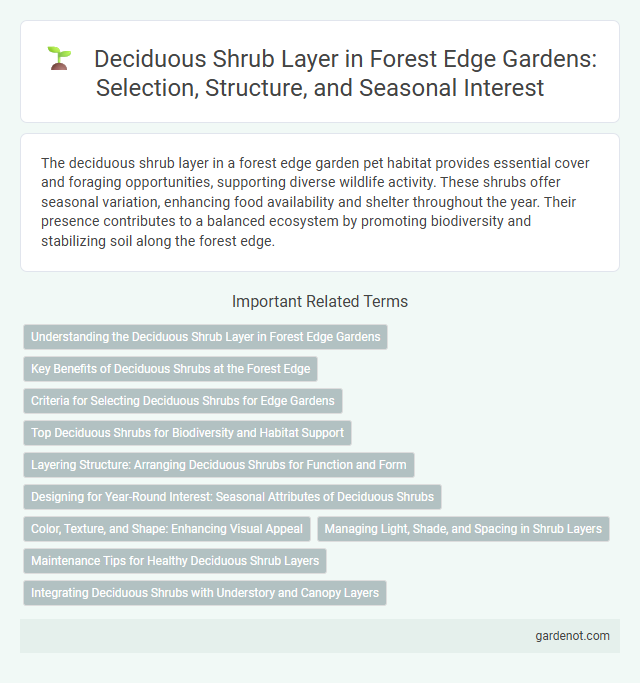The deciduous shrub layer in a forest edge garden pet habitat provides essential cover and foraging opportunities, supporting diverse wildlife activity. These shrubs offer seasonal variation, enhancing food availability and shelter throughout the year. Their presence contributes to a balanced ecosystem by promoting biodiversity and stabilizing soil along the forest edge.
Understanding the Deciduous Shrub Layer in Forest Edge Gardens
The deciduous shrub layer in forest edge gardens plays a crucial role in biodiversity by providing habitat and food sources for various wildlife species. These shrubs, which shed leaves seasonally, contribute to soil fertility through organic matter decomposition and support understory plants by moderating microclimates. Selecting native deciduous shrubs such as viburnums, dogwoods, and spicebush enhances ecological balance and promotes pollinator activity along forest edges.
Key Benefits of Deciduous Shrubs at the Forest Edge
Deciduous shrubs at the forest edge enhance biodiversity by providing seasonal habitat and food sources for various wildlife species, including birds and pollinators. Their leaf drop enriches soil fertility through natural nutrient cycling, supporting undergrowth plants and maintaining ecosystem health. These shrubs also act as effective windbreaks, reducing soil erosion and creating microclimates that protect young trees and other vegetation.
Criteria for Selecting Deciduous Shrubs for Edge Gardens
Deciduous shrubs for forest edge gardens should be selected based on site-specific factors such as soil type, light availability, and moisture levels to ensure optimal growth and establishment. Preference is given to native species that provide seasonal interest through vibrant fall foliage, supporting local wildlife by offering food and habitat. Shrubs with moderate growth rates and resilient root systems enhance erosion control and maintain garden structure along transitional zones.
Top Deciduous Shrubs for Biodiversity and Habitat Support
Top deciduous shrubs such as serviceberry (Amelanchier spp.), spicebush (Lindera benzoin), and ninebark (Physocarpus opulifolius) provide essential food and shelter for pollinators, birds, and small mammals in forest edge gardens. These species contribute to biodiversity by offering nectar, berries, and nesting sites throughout the growing season. Incorporating a diverse mix of native deciduous shrubs enhances habitat complexity and supports local wildlife populations year-round.
Layering Structure: Arranging Deciduous Shrubs for Function and Form
Deciduous shrub layers in a forest edge garden create a dynamic transition between ground cover and canopy trees, enhancing biodiversity and aesthetic appeal. Strategic layering of species such as viburnums, hazels, and dogwoods facilitates seasonal interest through varied foliage textures and vibrant autumn colors. Proper arrangement supports habitat complexity, soil stabilization, and phased light penetration essential for understory health.
Designing for Year-Round Interest: Seasonal Attributes of Deciduous Shrubs
Deciduous shrubs in forest edge gardens provide dynamic seasonal interest through their changing foliage color, flowering patterns, and fruiting displays. Selecting species such as hydrangeas, viburnums, and witch hazel ensures vibrant spring blossoms, rich summer greens, striking autumn hues, and textured winter silhouettes. Incorporating a variety of these shrubs enhances biodiversity and creates layered visual appeal throughout all seasons.
Color, Texture, and Shape: Enhancing Visual Appeal
Deciduous shrub layers in a forest edge garden provide vibrant seasonal color shifts that enhance visual interest throughout the year. Their diverse leaf textures, ranging from smooth to serrated, add tactile variety, while varied shapes--such as rounded, oval, or arching forms--create dynamic structural contrasts. Selecting species with complementary hues and forms elevates the garden's aesthetic appeal and supports biodiversity.
Managing Light, Shade, and Spacing in Shrub Layers
Deciduous shrub layers in forest edge gardens require careful management of light, shade, and spacing to promote healthy growth and biodiversity. Optimal spacing ensures adequate sunlight penetration while preventing overcrowding, which can lead to increased disease susceptibility and stunted development. Pruning and selective thinning techniques help maintain an open canopy, allowing filtered light to reach lower shrub layers and support a diverse understory ecosystem.
Maintenance Tips for Healthy Deciduous Shrub Layers
Regular pruning of deciduous shrub layers in forest edge gardens promotes vigorous growth and prevents overcrowding, enhancing air circulation and light penetration. Applying mulch around the base helps retain soil moisture, suppress weeds, and regulate temperature fluctuations critical for shrub health. Monitoring for pests and diseases early enables timely intervention, ensuring sustainable growth and vibrant foliage throughout the growing season.
Integrating Deciduous Shrubs with Understory and Canopy Layers
Deciduous shrubs in forest edge gardens create a vital transitional layer that enhances biodiversity by linking the understory and canopy layers. Species such as serviceberry (Amelanchier spp.) and spicebush (Lindera benzoin) provide seasonal foliage variation, wildlife habitat, and nutrient cycling, fostering ecosystem resilience. Proper spacing and selection aligned with light availability ensure shrubs contribute to structural complexity while supporting pollinators and birds.
Deciduous shrub layer Infographic

 gardenot.com
gardenot.com